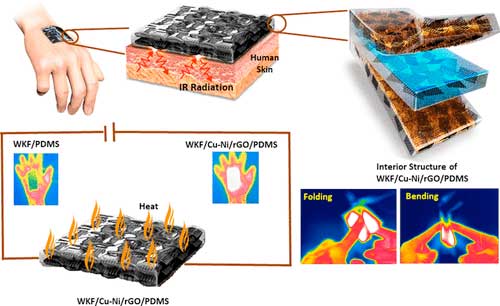| Oct 31, 2018 | |
A bullet-proof nanowire heating pad(Nanowerk News) Sometimes nothing feels better on stiff, aching joints than a little heat. But many heating pads and wraps are rigid and provide uneven warmth, especially when the person is moving around. Researchers have now made a wearable heater by modifying woven Kevlar® fabric with nanowires that conduct and retain heat. |
|
| They report their results in Nano Letters ("Woven Kevlar Fiber/Polydimethylsiloxane/Reduced Graphene Oxide Composite-Based Personal Thermal Management with Freestanding Cu–Ni Core–Shell Nanowires"). | |

|
|
| Even at rest, the human body produces a lot of heat, but most of this warmth dissipates to the air and is wasted. Cold-weather clothing is often made from materials that keep heat close to the body, offering thermal insulation. For even more warmth, scientists have tried coating textiles with metallic nanowires that can be heated with a small battery. | |
| However, researchers are still searching for a material that provides good thermal conductivity and insulation while being safe, inexpensive, durable and flexible. | |
| Hyung Wook Park and colleagues wondered if they could make a wearable heating device by incorporating metallic nanowires into Kevlar®, the famous bullet-proof fiber used in many types of body armor. | |
| To make their wearable heater, the team grew copper-nickel nanowires between two Kevlar® sheets. They filled in the spaces between the nanowires with a resin containing reduced graphene oxide to encourage uniform heating. Applying a low voltage (1.5 volts) to the composite material caused a rapid and uniform increase in surface temperature to 158 F -- a typical "high" setting on a heating pad. | |
| In another experiment, the team showed that the material acted as a thermal insulator by reflecting infrared radiation emitted from a hot plate set at human body temperature. The fabric was strong, flexible, breathable and washable, while still absorbing impacts similar to regular Kevlar®. | |
| In addition to wearable heat therapy, the new material could be used to make heated body armor for police and military personnel in cold climates, the researchers say. |
| Source: American Chemical Society | |
|
Subscribe to a free copy of one of our daily Nanowerk Newsletter Email Digests with a compilation of all of the day's news. |
